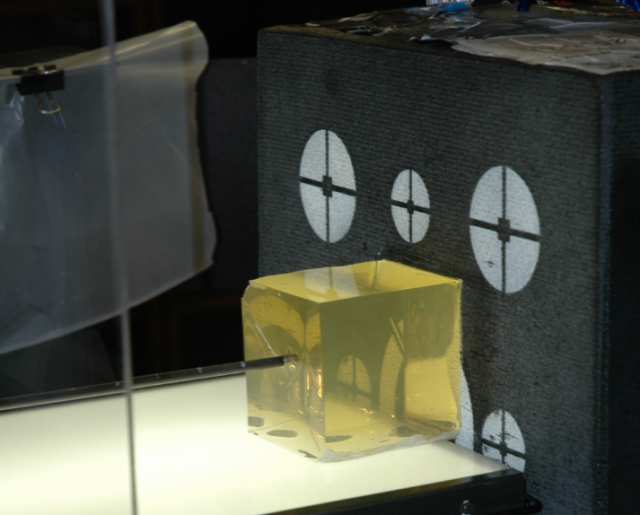BTN.com staff, May 9, 2016
Take a moment and picture in your mind a college biology laboratory?
Did you envision a crossbow shooting arrows into ballistics gelatin? Probably not. However, that was the recent setup for Philip Anderson, assistant professor of animal biology at the University of Illinois.

Anderson - along with researchers Jeffrey LaCosse from Charles E. Jordan High School in Durham, N.C., and Mark Pankow of North Carolina State University - studied how various creatures in the wild use their fangs, claws, tentacles and other appendages to puncture animals and materials for food and survival.
The subject matter may seem bizarre to the uninitiated, but it?s nothing new for Anderson.
?Ever since I was a Ph.D. student [at the University of Chicago], which was close to nine years ago, I?ve been interested in the biomechanics of cutting and fracture,? he explained. ?I started looking at how tooth shape alters the ability to break down different food materials.?
He and his colleagues originally intended to examine how the shape of teeth and other body parts affects an animal?s ability to pierce through material. But they realized that they needed to develop a more basic understanding of these processes first.
?What became obvious really quickly is that we didn?t even know how things like speed or scale would actually affect the ability to puncture,? Anderson said. ?Before we can even get into the morphology, we have to understand how size and speed affect the situation.
[btn-post-package]?One of the reasons I started doing this work with high-speed puncture was that in nature, most cutting or puncture events are not happening slowly - they are happening quite fast,? he added. ?One obvious example is a snake strike. When a venomous snake strikes, it?s impacting and trying to pierce either its prey or an aggressor with its fangs in order to inject venom.?
The ability to puncture with the aid of speed is integral for many animals, including snakes, mantis shrimp, woodpeckers, some ants and even jellyfish.
?You also see very high-speed puncture in stinging jellyfish,? Anderson said. ?In a Portuguese man o? war or similar stinging jellyfish, the tentacles are covered by tiny, single-celled organs called nematocysts. These highly pressurized cells shoot out harpoon-like structures to inject poison.
?And so you have all these different animals, a snake, a crustacean and a jellyfish, and they?re all doing the same thing. They are trying to puncture another material using a sharpened tool that is launched at very high speeds.?
To simulate the puncture that these animals frequently exploit, Anderson and his colleagues got a big wooden frame with attached archery bows. The device was previously used by an anthropologist at Duke University (where Anderson worked prior to Illinois) to study the evolution of weaponry.
?We tied it down to a lab table to keep it in place and used it to launch standard archery arrows into ballistics gel,? he said. ?We did this with various speeds and with different weights. The arrows were hollow, so we could fill them with different lengths of lead wire to alter the weight of the arrow.?
 The researchers then measured the depth at which the arrow penetrated the gelatin to determine the success level of the puncture. They found that the best predictor of ability to pierce is kinetic energy, or mass multiplied by velocity squared.
The researchers then measured the depth at which the arrow penetrated the gelatin to determine the success level of the puncture. They found that the best predictor of ability to pierce is kinetic energy, or mass multiplied by velocity squared.
?What that means, biologically speaking, is if you?re an animal and you need a certain amount of kinetic energy to successfully puncture, but you?re very small, one way to get more kinetic energy is to ramp up the speed,? Anderson said.
This study is just the tip of the iceberg - or arrow, if you like - for Anderson, who started at Illinois this winter. He hopes these results will propel this research forward in Champaign.
?I have made several connections in the engineering school here at Illinois to help continue this work, people who are interested in aspects of puncture and fracture in different materials,? he said. ?This is the definitely the first of what?s hopefully going to be a big, multi-step project going forward.?
By Jason Dorow







